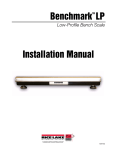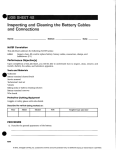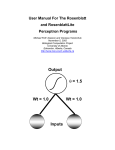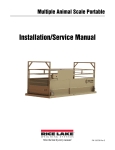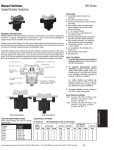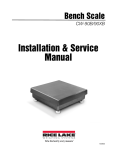Download Rice Lake Benchmark LP Installation manual
Transcript
® Benchmark LP Low-Profile Bench Scale Installation Manual 104742 Rev A Contents 1.0 Introduction..................................................................................................................................... 1 1.1 Safety . . . . . . . . . . . . . . . . . . . . . . . . . . . . . . . . . . . . . . . . . . . . . . . . . . . . . . . . . . . . . . . . . . . . . . . . . 2 2.0 Installation ...................................................................................................................................... 3 2.1 2.2 2.3 2.4 3.0 Site Preparation . . . . . . . . . . . . . . . . . . . . . . . . . . . . . . . . . . . . . . . . . . . . . . . . . . . . . . . . . . . . . . . . . Unpacking and Assembly . . . . . . . . . . . . . . . . . . . . . . . . . . . . . . . . . . . . . . . . . . . . . . . . . . . . . . . . . . Summing Board Security . . . . . . . . . . . . . . . . . . . . . . . . . . . . . . . . . . . . . . . . . . . . . . . . . . . . . . . . . . . Electrical Interface to Indicator . . . . . . . . . . . . . . . . . . . . . . . . . . . . . . . . . . . . . . . . . . . . . . . . . . . . . . . 3 3 4 4 Adjustments and Calibration .......................................................................................................... 6 3.1 Mechanical Adjustments . . . . . . . . . . . . . . . . . . . . . . . . . . . . . . . . . . . . . . . . . . . . . . . . . . . . . . . . . . . 6 3.2 Corner Correction . . . . . . . . . . . . . . . . . . . . . . . . . . . . . . . . . . . . . . . . . . . . . . . . . . . . . . . . . . . . . . . . 6 3.3 Calibration Procedure . . . . . . . . . . . . . . . . . . . . . . . . . . . . . . . . . . . . . . . . . . . . . . . . . . . . . . . . . . . . . 7 4.0 Service Information ........................................................................................................................ 8 4.1 Troubleshooting Guide. . . . . . . . . . . . . . . . . . . . . . . . . . . . . . . . . . . . . . . . . . . . . . . . . . . . . . . . . . . . . 8 4.2 Periodic Maintenance . . . . . . . . . . . . . . . . . . . . . . . . . . . . . . . . . . . . . . . . . . . . . . . . . . . . . . . . . . . . . 8 4.3 Load Cell Replacement . . . . . . . . . . . . . . . . . . . . . . . . . . . . . . . . . . . . . . . . . . . . . . . . . . . . . . . . . . . . 9 4.3.1 Load Cell Wiring to Summing Board . . . . . . . . . . . . . . . . . . . . . . . . . . . . . . . . . . . . . . . . . . . . . . . . . . . . 10 4.4 Replacement Load Cells . . . . . . . . . . . . . . . . . . . . . . . . . . . . . . . . . . . . . . . . . . . . . . . . . . . . . . . . . . 10 Benchmark LP Limited Warranty .............................................................................................................. 11 Technical training seminars are available through Rice Lake Weighing Systems. Course descriptions and dates can be viewed at www.ricelake.com/training or obtained by calling 715-234-9171 and asking for the training department. © Rice Lake Weighing Systems. All rights reserved. Printed in the United States of America. Specifications subject to change without notice. Rice Lake Weighing Systems is an ISO 9001 registered company. November 19, 2014 Contents i Rice Lake continually offers web-based video training on a growing selection of product-related topics at no cost. Visit www.ricelake.com/webinars. ii Benchmark Series Low-Profile Bench Scale 1.0 Introduction The CubeLogic 250 is a four-cell, low-profile scale. Features include: • Available in sizes from 18 in. x 18 in (.46 m x 46 m) to 36 in x 36 in (.91 m x .91 m). • Capacities from 100 to 1000 lbs (45 - 453 kg). • Fully electronic low-profile load receivers. • Four corner-mounted, FM-approved planar beam load cells. • Signal-trim summing board for any necessary corner corrections, mounted under a stainless steel cover that can be sealed for legal-for-trade. • All models come pre-trimmed; corner corrections should not be necessary. • Load cell cables are held down with replaceable cable ties near each corner. • Adjustable feet can be used to allow leveling of the scale to compensate for minor floor irregularities. Holes are located in the lower frame to be used for permanent mounting applications.This manual is intended for use by service technicians responsible for installing and servicing the Benchmark™ LP low-profile bench scale. Authorized distributors and their employees can view or download this manual from the Rice Lake Weighing Systems distributor site at: www.ricelake.com Model Designations The model identification label is located on the side of the frame. Include both model number and serial number when ordering replacement parts. Electrical Grounding For systems where the scale is connected to a 115 VAC circuit, the indicator must be directly connected to an earth ground with a ground interface cable of no more than 3Ω resistance throughout its length. Load Cells • • Four (4) Rice Lake RLBLP (planar beam) Rated Excitation: 5-15 VDC Grade Level Requirement The supporting surface of the scale (encompassing four feet) must be level within 1/4 in of horizontal. End Load Capacity 60% of full scale capacity. Platform Dimensions, Capacity, and Torque Specs Part No. Capacity Platform Dimensions (LxWxH) Torque To 97662 100 lb 18” x 18” x 1.67” (2.63“ with leveling feet) 50 LB PER IN 97663 250 lb 18” x 18” x 1.74” (2.50“ with leveling feet) 125 LB PER IN 97664 500 lb 18” x 18” x 1.93” (2.69“ with leveling feet) 125 LB PER IN 97665 100 lb 24” x 24” x 1.69” (2.66“ with leveling feet) 50 LB PER IN 97666 250 lb 24” x 24” x 2.07” (2.83“ with leveling feet) 125 LB PER IN 97667 500 lb 24” x 24” x 2.26” (3.02“ with leveling feet) 125 LB PER IN 97668 500 lb 30” x 30” x 2.26” (3.02“ with leveling feet) 125 LB PER IN 97669* 1000 lb 30” x 30” x 2.70” (3.47“ with leveling feet) 20 LB PER FT 97670 500 lb 36” x 36” x 2.26” (3.02“ with leveling feet) 125 LB PER IN 97671* 1000 lb 36” x 36” x 2.70” (3.47“ with leveling feet) 20 LB PER FT Table 1-1. Platform dimensions and capacity *Non-NTEP Introduction 1 1.1 Safety Safety Symbol Definitions: Indicates a potentially hazardous situation that, if not avoided could result in death or serious injury, and WARNING includes hazards that are exposed when guards are removed. Indicates information about procedures that, if not observed, could result in damage to equipment or Important corruption to and loss of data. General Safety Do not operate or work on this equipment unless you have read and understand the instructions and warnings in this manual. Failure to follow the instructions or heed the warnings could result in injury or death. Contact any Rice Lake Weighing Systems dealer for replacement manuals. Proper care is your responsibility. WARNING Failure to heed may result in serious injury of death. DO NOT allow minors (children) or inexperienced persons to operate this unit. DO NOT operate without all shields and guards in place. DO NOT jump on the scale. DO NOT use for purposes other then weight taking. DO NOT place fingers into slots or possible pinch points. DO NOT use any load bearing component that is worn beyond 5% of the original dimension. DO NOT use this product if any of the components are cracked. DO NOT exceed the rated load limit of the unit. DO NOT make alterations or modifications to the unit. DO NOT remove or obscure warning labels. Before opening the unit, ensure the power cord is disconnected from the outlet. Keep hands, feet and loose clothing away from moving parts. 2 Benchmark Series Low-Profile Bench Scale 2.0 Installation Standard installation of the Benchmark™ LP floor scale consists of the following steps: • Select a site • Check levelness and smoothness of site • Unpack scale • Adjust the four feet on the scale • Connect cable to summing board and indicator • Calibrate the unit 2.1 Site Preparation The scale must not be loaded beyond its capacity, even momentarily. Do not select a site where overweight loads would have to maneuver to avoid crossing the platform. Avoid areas where the scale might receive damaging side impacts from wheels or forklift tines, or shock damage from falling objects. Avoid areas where water may damage the scale. The interface cable between the scale and the indicator must be protected against crushing, cutting, or moisture damage. If the chosen site has such potential dangers, some method of protection, such as running the cable in conduit, will be necessary. In operation, the scale must be level within 1/4 inch. Either choose a site where the floor is close to this standard to avoid excessive shimming, or modify the floor at the chosen site to meet this standard. 2.2 Unpacking and Assembly 1. Remove all packing material and inspect scale for visible damage caused during shipment. 2. Remove the four overload stops on the underside of the scale, shown in Figure 2-1. Overload Stops Overload Stops Figure 2-1. Overload Stops to be Removed (4) 3. 4. 5. 6. 7. 8. 9. 10. 11. 12. Remove the black scale cover. Remove the summing board cover in the center of the scale. Wire the homerun cable. Refer to instructions in Section 2.3 on page 4. Properly secure the cable with nylon ties (supplied). Using the bubble level next to the summing board, ensure the scale is level. Replace the black scale cover and use the four mounting screws to secure it in place. If necessary, perform a corner correction. See Section 3.2 on page 6. Replace the summing board cover. Replace the black center cover. Set the stainless steel cover on the scale. Installation 3 2.3 Summing Board Security After an NTEP inspector has examined the unit, he/she will install security cables on the summing board cover. These cables prevent the summing board from being tampered with by an unauthorized individual. If these cables are removed, NTEP Certification will become void. Figure 2-2. Summing board cover with security cables installed 2.4 Electrical Interface to Indicator Twenty feet of 6-wire cable to connect the scale to the weight indicator is supplied with each scale. Both ends have the wires stripped and tinned. To access the summing board, 1. 2. 3. 4. Remove the stainless steel platform. Remove lid in the center of the platform, revealing the summing board cover plate. Remove security cables (this will void NTEP Certification). Remove screws on the summing board cover plate and remove lid. Wire Connections Remove the summing board cover and connect the wires to the INDICATOR terminal (Figure 2-3). To connect the indicator wires to the appropriate connectors, push in the quick connect lever with a small screwdriver or ballpoint pen. When holding the lever, insert the appropriate wire into the exposed wire opening. EXP -EX +SI S I G N A L -SI SHD +EX +SE -EX -SE +SI -SI SHD T R I M +SI -SI SHD -SI +SI PT4 JP4 PT3 JP3 S2C Figure 2-3. Summing Board Indicator Terminal 4 SHD -EX 1 -EX -EX S I G N A L CELL3 +SI +EX IND +EX T R I M CELL4 -SI JP2 1 SHD PT2 JP1 1 PT1 CELL2 CELL1 1 +EX Benchmark Series Low-Profile Bench Scale +EX Cable Routing The cable must be routed to the indicator in a manner that will protect the cable from damage. When planning cable routing, leave a loose coil of excess cable under the scale to facilitate future lifting of the scale for servicing or cleaning. 1. When the interface cable is protected and in its final position, complete connections to the indicator. See indicator installation manual for wiring information. 2. If necessary, trim corners as described in Section 3.2 on page 6. 3. Check all strain relief for tightness. Figure 2-4. Homerun Cable Wired to Summing Board and Secured With Nylon Ties Installation 5 3.0 3.1 Adjustments and Calibration Mechanical Adjustments To accommodate minor floor unevenness, scale feet can be used to adjust scale height up or down a fraction of an inch. Adjust the feet by hand (lift the scale corner slightly with a pry bar) until all feet are contacting the floor equally. Jam nuts are supplied for locking the feet in place. When height adjustments are complete, recheck level of the deck with a spirit level. The deck must be level within 1 /4". 3.2 Corner Correction All assembled Benchmark™ LP scales are delivered with the summing board corner-trimmed. Corner trimming is only necessary after replacing a load cell. To calibrate the scale, the output from each load cell must be matched by adjusting the signals with potentiometers at the summing board—a process known as trimming. 1. Remove the summing board cover and identify the correct load cell terminal corresponding to each corner (labeled CELL 1, CELL 2, and so on). See Figure 4-3 on page 10 for scale deck corner numbering. 2. The indicator must be connected and calibrated approximately, but it need not indicate the exact weight value. A test weight will be required. The recommended test weight for all Benchmark™ LP models is 25% of scale capacity: for example, 25 lbs for 100-lb models, 250 lbs for 1000-lb models. 3. With no weight on the scale, zero the indicator. 4. Turn all four potentiometers fully clockwise (shaded areas of Figure 3-1) to increase the reading until a clicking sound is heard from each potentiometer. This ensures the maximum signal from each load cell. Jumper Locations JP1 and JP2 Shaded EXP -EX S I G N A L +SI -SI SHD +EX +SE -EX -SE +SI -SI SHD T R I M +SI -SI SHD SHD -SI +SI -EX 1 -EX -EX S I G N A L CELL3 +SI +EX IND +EX T R I M CELL4 -SI JP2 1 SHD PT2 JP1 1 PT1 CELL2 CELL1 1 +EX Potentiometers PT4 JP4 Jumper Locations JP3 and JP4 Shaded PT3 JP3 S2C +EX Potentiometers Figure 3-1. Trim Potentiometers 5. Zero the indicator and place 25% of scale capacity using calibrated test weights over each load cell in turn. 6. Record the value displayed on the indicator after the test weight is placed in turn on each corner (directly over the load cell) without allowing the weight to overhang the sides. Allow the scale to return to zero each time to check for friction or other mechanical problems. Select the load cell which has the lowest value as your reference point. This cell will not be trimmed. 7. Replace the same test load over each cell in turn. Using the corresponding potentiometer, trim each cell down to equal the reference load cell. As corner corrections are somewhat interactive, check all cells again for repeatability. If necessary, repeat steps 5 and 6. 6 Benchmark Series Low-Profile Bench Scale 3.3 Calibration Procedure Refer to the indicator manual to determine correct calibration procedures. It is recommended that the scale be "exercised" before calibration to be certain that everything is seated. 1. Load the scale to near capacity two or three times. 2. With no load on the scale, place the indicator in its calibration mode and perform a zero calibration. 3. Place test weights on the platform not exceeding the scale's full capacity. If several weights are used, they should be evenly distributed around the platform. 4. Perform a span calibration. Adjustments and Calibration 7 4.0 4.1 Service Information Troubleshooting Guide System does not operate—no display • Power disconnected: Check and reconnect. • Indicator fuse blown. Replace fuse. Check for cause. • Interface cable cut or disconnected: Repair. • Signal leads incorrectly installed at indicator: Install according to indicator installation manual Display stays at zero • Indicator faulty: Service indicator • Load cell connections faulty: Check cable connections in summing board and at indicator Erratic weights • Vibration near scale: Remove source of vibration or move scale. • Platform not level to within 1/4 in: Level scale by adjusting feet or shimming if necessary. • • • Load cell or cable water damage: Replace. Debris under load cells or platform: Clean. Indicator faulty: Use simulator to test indicator for stability. Service indicator. Consistently high or low weights • Indicator not properly adjusted to zero: Zero the indicator according to indicator manual. • Platform binding: Obtain adequate clearance for free platform movement. • Indicator not calibrated: Calibrate according to indicator manual and Section 3.3 • Load cells faulty: Test and replace load cells if necessary. • Feet touching deck underside: Adjust feet downward to provide clearance. 4.2 Periodic Maintenance The space beneath the platform must be periodically cleaned to prevent debris buildup. Do not attempt to use scales with load cells that are not hermetically sealed in washdown applications. Important Water damage is a common cause of failure in non-hermetically-sealed load cells. Use care with high pressure steam washdowns for hermetically-sealed load cells. The steam may not damage the load cells, but the elevated temperatures may cause incorrect readings until the unit cools to room temperature. 8 Benchmark Series Low-Profile Bench Scale 4.3 Load Cell Replacement Replacement load cells can be ordered from Rice Lake Weighing Systems according to the part numbers in Table 4-2 on page 10. Refer to Table 1-1 on page 1 for torque settings. 1. Remove defective load cells. 2. Disconnect load cell cable from summing board and cut cable ties. 2 3 1 4 Figure 4-1. Load Cell Arrangement 3. When the cable is freed, pull cable out of the scale. 4. Lay out each load cell near the corner where it is to be installed. 5. Attach the cable from each load cell along the frame and into the summing board as shown in Figure 4-1. In Figure 4-1, both the scale and the summing board are viewed from the top. To verify correct load cell/ Note summing board terminal matching, see the numbers on the terminals inside the summing board. 6. Check that the threaded holes for the load cell screws are free of debris. Use compressed air to blow out holes if necessary. 7. Position load cells with capacity label and load cell wires facing up, and loosely install the hex head cap screws (provided). 8. Route the load cell cables along the frame to the summing board. 9. Secure the cable in position with the adhesive-backed cables tied supplied in the hardware kit. See Figure 4-2 for an illustration of load cell and cable placement. Note Do not cut load cell cables. Figure 4-2. Load cell and wire placement 10. Corner correction trimming and calibration is necessary after load cell replacement. Follow the instructions in Section 3.2 and Section 3.3. Service Information 9 4.3.1 Load Cell Wiring to Summing Board The four load cells are each wired to their respective terminals in the summing board according to the corner numbering system shown in Figure 4-3 and the coloring code in Table 4-1. Hole for homerun cable 3 4 2 1 Figure 4-3. Corner numbering (top view) Cable Color Code Summing Board Terminal Green + Excitation Black - Excitation White + Signal Red - Signal Table 4-1. Load Cell Wiring 4.4 Replacement Load Cells Capacity of Scale Load Mount Load Cell 100 lbs 96823 100272 250 lbs 96824 104645 500 lbs 96825 100273 1000 lbs 96826 100274 Table 4-2. Replacement load cells 10 Benchmark Series Low-Profile Bench Scale Benchmark LP Limited Warranty Rice Lake Weighing Systems (RLWS) warrants that all RLWS equipment and systems properly installed by a Distributor or Original Equipment Manufacturer (OEM) will operate per written specifications as confirmed by the Distributor/OEM and accepted by RLWS. All systems and components are warranted against defects in materials and workmanship for two years. RLWS warrants that the equipment sold hereunder will conform to the current written specifications authorized by RLWS. RLWS warrants the equipment against faulty workmanship and defective materials. If any equipment fails to conform to these warranties, RLWS will, at its option, repair or replace such goods returned within the warranty period subject to the following conditions:| • • • • • • Upon discovery by Buyer of such nonconformity, RLWS will be given prompt written notice with a detailed explanation of the alleged deficiencies. Individual electronic components returned to RLWS for warranty purposes must be packaged to prevent electrostatic discharge (ESD) damage in shipment. Packaging requirements are listed in a publication, “Protecting Your Components From Static Damage in Shipment,” available from RLWS Equipment Return Department. Examination of such equipment by RLWS confirms that the nonconformity actually exists, and was not caused by accident, misuse, neglect, alteration, improper installation, improper repair or improper testing; RLWS shall be the sole judge of all alleged non-conformities. Such equipment has not been modified, altered, or changed by any person other than RLWS or its duly authorized repair agents. RLWS will have a reasonable time to repair or replace the defective equipment. Buyer is responsible for shipping charges both ways. In no event will RLWS be responsible for travel time or on-location repairs, including assembly or disassembly of equipment, nor will RLWS be liable for the cost of any repairs made by others. These warranties exclude all other warranties, expressed or implied, including without limitation warranties of merchantability or fitness for a particular purpose. Neither RLWS nor distributor will, in any event, be liable for incidental or consequential damages. RLWS and buyer agree that RLWS’ sole and exclusive liability hereunder is limited to repair or replacement of such goods. In accepting this warranty, the buyer waives any and all other claims to warranty. Should the seller be other than RLWS, the buyer agrees to look only to the seller for warranty claims. No terms, conditions, understanding, or agreements purporting to modify the terms of this warranty shall have any legal effect unless made in writing and signed by a corporate officer of RLWS and the Buyer. © Rice Lake Weighing Systems, Inc. Rice Lake, WI USA. All Rights Reserved. RICE LAKE WEIGHING SYSTEMS • 230 WEST COLEMAN STREET • RICE LAKE, WISCONSIN 54868 • USA 11 12 Benchmark Series Low-Profile Bench Scale 230 W. Coleman St. • Rice Lake, WI 54868 • USA U.S. 800-472-6703 • Canada/Mexico 800-321-6703 • International 715-234-9171 • Europe +31 (0)26 472 1319 www.ricelake.com www.ricelake.mx www.ricelake.eu www.ricelake.co.in m.ricelake.com © Rice Lake Weighing Systems 11/19/14 PN 104742 Rev A


















